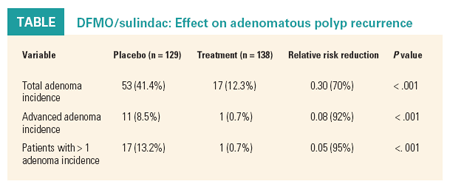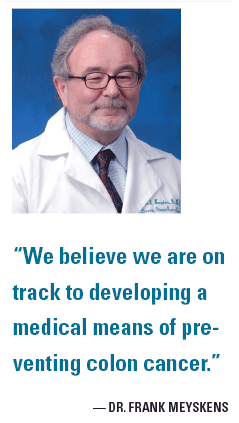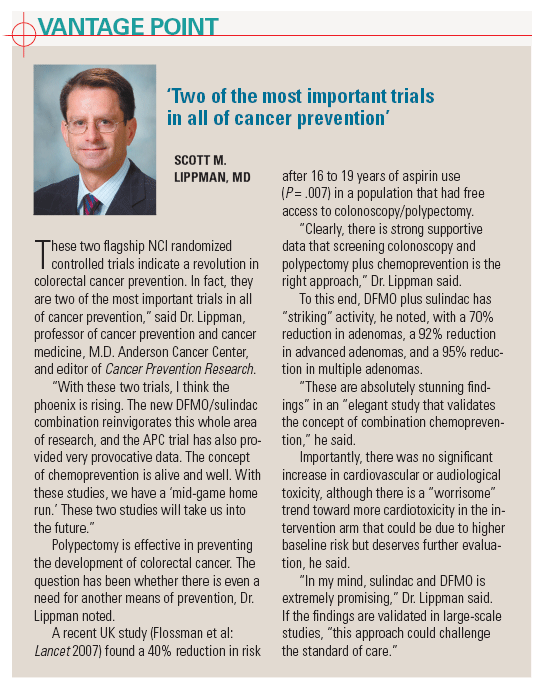Chemoprevention of polyps now a reality
In a landmark trial, DFMO plus sulindac reduced the risk of advanced adenomas by 92% in high-risk patients, with low toxicity.
SAN DIEGO-Chemoprevention of adenomatous polyps, the major precursor to colon cancer, is possible. In fact, one drug combination reduced the risk of advanced adenomas by more than 90%, in a study reported at the 2008 American Association for Cancer Research annual meeting (abstract LB-142).
A combination of low-dose difluoromethylornithine (DFMO) and sulindac, a non-steroidal anti-inflammatory drug, given for 3 years reduced the risk of a recurrent adenoma by 70%. The polyp rates fell from 41.1% with placebo to 12.3% with intervention.
The advanced adenoma rate was reduced from 8.5% to 0.7% with the combination treatment, for a 92% reduction, reported Frank Meyskens, MD, director of the Chao Family Comprehensive Cancer Center and Daniel G. Aldrich, Jr., Endowed Chair and Professor of Medicine and Biological Chemistry at the University of California, Irvine.
“The reduction in adenomas is the largest seen in any trial to date. We believe we are on track to developing a medical means of preventing colon cancer,” Dr. Meyskens said at a press conference.
The study was simultaneously reported in the inaugural issue of Cancer Prevention Research.
Trial stopped early
The trial enrolled 375 patients with a history of at least one colorectal polyp (mean, 2.5) within the previous 5 years. Patients were randomized to DFMO 500 mg plus sulindac 150 mg daily or placebo, and followed for 3 years. The relative risk reduction was so great in the treatment arm that the Data and Safety Monitoring Committee stopped the trial early.

DFMO works by inhibiting polyamines, which, when elevated, lead to the proliferation and differentiation of many tissues, increasing the risk of cancer. Combining DFMO with sulindac allows for lower doses of each drug, thus less toxicity potential, with the possibility of additive effects, Dr. Meyskens said. In fact, he added, sulindac has been shown to have an unexpected effect on polyamine catabolism.
Marked reduction of polyps
Marked reductions in the occurrence of all adenomas, advanced adenomas, and multiple recurrent adenomas were observed (see Table). In addition there was a highly significant reduction in polyamine content that persisted out to 36 months (P < .0001) and corresponded to the reduction in adenoma recurrence.
“One could not ask for a better clinical outcome,” Dr. Meyskens said.
Toxicities were low and comparable in the two arms. Due to concerns about ototoxicity with DFMO (observed in other studies), careful serial audiograms were performed. These showed subclinical changes that were more frequent in the intervention arm but were largely reversible after 6 months off treatment.
“We designated a decrease of 15 dB in two consecutive frequencies as significant. With this degree of hearing loss, you would not hear leaves rustling or maybe a ‘th’ sound at high frequency. The change was 1 to 2 dB greater in the DFMO/sulindac group-a sound equivalent to rubbing two fingers together,” Dr. Meyskens reported.
Longer-term studies are needed to determine whether this combination can reduce colorectal cancer incidence or improve or complement existing surveillance strategies, Dr. Meyskens said. These studies are being planned for three risk groups: persons with familial adenomatous polyposis (FAP), persons with advanced adenomas, and persons with prior low-stage colorectal cancer.
Celecoxib protective but less safe
The Adenoma Prevention With Celecoxib (APC) Trial also showed the possibility of preventing adenomas (abstract LB-141). In high-risk patients, celecoxib (Celebrex) had persistent efficacy at 3 and at 5 years, but it was also associated with an increase in cardiovascular and thrombotic adverse events, especially in patients with pre-existing cardiovascular risk factors, reported Monica M. Bertagnolli, MD, chief of surgical oncology, Dana-Farber/Brigham and Women’s Cancer Center.

The study randomized 2,035 high-risk persons to celecoxib 200 mg twice daily, celecoxib 400 mg twice daily, or placebo. In the core study, subjects received 3 years of medication. In the extension study, subjects were to receive a total of 5 years of medication; however, medication use was discontinued in December 2004 upon the recognition of cardiovascular toxicity associated with the COX2 inhibitors.
At the 5-year time point, adenoma incidence was reduced by 14% with celecoxib 200 mg twice daily and by 12% with celecoxib 400 mg twice daily (P < .01). Advanced adenomas were reduced by 41% and 26%, respectively (P < .01), Dr. Bertagnolli reported. The results were slightly less impressive than the 3-year results but still significant.
Cardiovascular toxicity, however, was a concern, especially with the 400 mg twice daily dose. Cardiovascular and thrombotic events occurred in 7.5% of patients receiving the higher dose, 6% of patients on the lower dose, and 3.8% of placebo recipients. Risk was higher among subjects who also reported regular aspirin use at baseline or had baseline cardiovascular/thrombotic risk factors.
Dr. Bertagnolli suggested that celecoxib should probably be limited to patients who are at high risk for adenomas but have a low cardiovascular risk, and in doses not exceeding 400 mg daily.

How Supportive Care Methods Can Improve Oncology Outcomes
Experts discussed supportive care and why it should be integrated into standard oncology care.